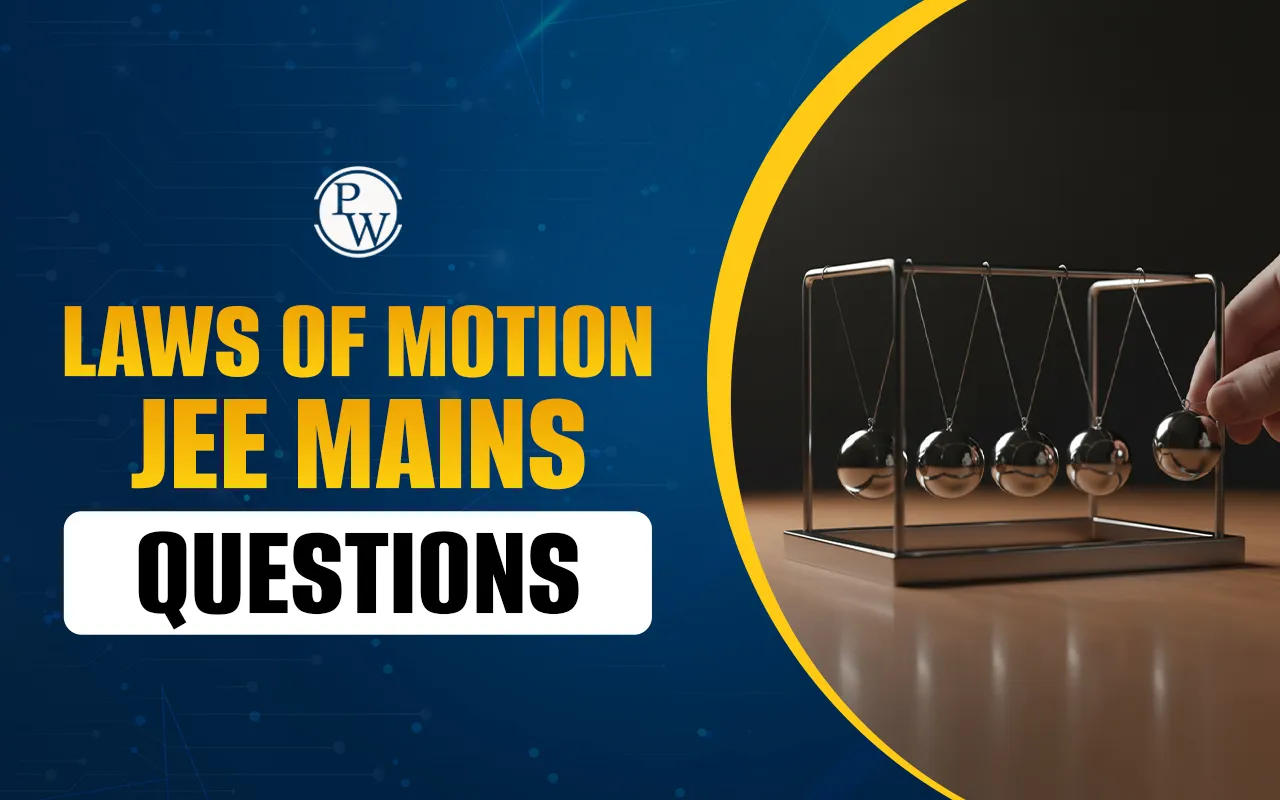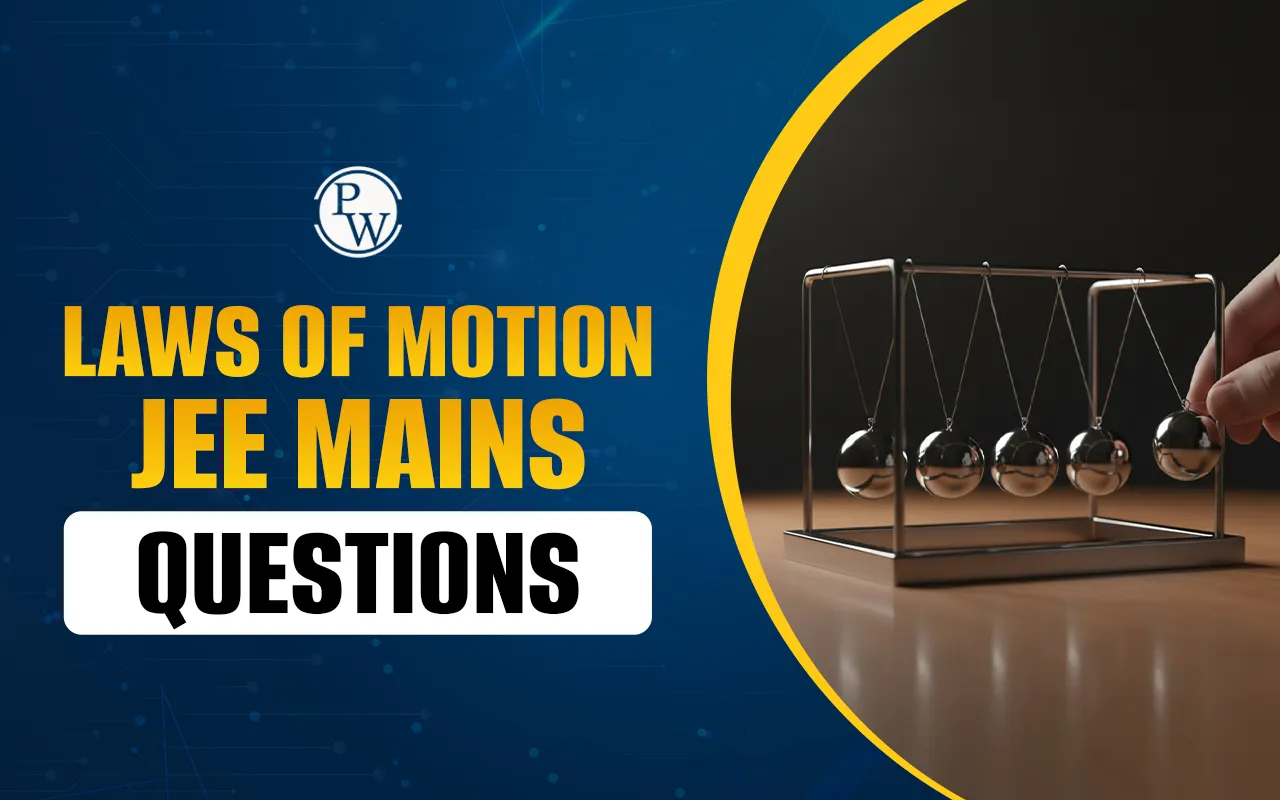

Laws of Motion JEE Mains questions from this chapter often include real-life applications such as resistive forces, block–pulley systems, and acceleration under applied forces. Practicing previous year questions and solving problems using free body diagrams improves accuracy and speed. Using resources like PDFs, solved examples, and standard books such as NCERT and HC Verma helps students build confidence for the exam.
The Laws of Motion are an important part of the JEE Mains Physics syllabus, with 1–2 questions asked every year. These questions test concepts like Newton’s laws, friction, pulleys, and motion on inclined planes. A strong understanding of force, mass, and acceleration helps students solve both numerical and conceptual problems quickly, making this chapter essential for scoring well.
Laws of Motion JEE Mains Questions
The Laws of Motion are a very important part of the JEE Mains Physics syllabus. Every year, students face several questions from this chapter in the exam. Understanding the laws of motion helps in solving problems related to force, mass, and acceleration. These concepts are the base for many other topics in physics, such as work, energy, and gravitation. For JEE aspirants, mastering laws of motion is a must for good marks.
Why Laws of Motion are Important for JEE?
Laws of Motion are important for JEE because they form the base of many physics concepts, appear frequently in JEE Mains, and help students solve both numerical and conceptual questions quickly.
-
Laws of motion questions are common in JEE Mains.
-
The chapter helps build a strong foundation for advanced physics topics.
-
Clear understanding helps in solving numerical and conceptual questions quickly.
Laws of Motion JEE Mains Important Questions
Most questions in JEE Mains on laws of motion are based on Newton’s three laws, free body diagrams, and problems involving friction, pulleys, and inclined planes. Here are some important types of questions asked in recent years:
Q1 A particle moving in the xy plane experiences a velocity dependent force
F→ = k (vy i^ + vx j^),
where vx and vy are the x and y components of its velocity v→. If a→ is the acceleration of the particle, then which of the following statements is true for the particle?
[JEE Main 2020, 6 Sep (Shift 2)]
(A) F→ arises due to a magnetic field
(B) quantity v→ ⋅ a→ is constant in time
(C) kinetic energy of particle is constant in time
(D) quantity v→ × a→ is constant in time
Q2 A small ball of mass m is thrown upward with velocity u from the ground. The ball experiences a resistive force mkv², where v is its speed. The maximum height attained by the ball is
[JEE Main 2020, 4 Sep (Shift 2)]
(A) 1/(2k) tan⁻¹ (ku² / 2g)
(B) 1/k ln (1 + ku² / 2g)
(C) 1/(2k) ln (1 + ku² / g)
(D) 1/k tan⁻¹ (ku² / 2g)
Q3 A block of mass m slides along a floor while a force of magnitude F is applied to it at an angle θ as shown in figure. The coefficient of kinetic friction is μK. Then, the block’s acceleration ‘a’ is given by: (g is acceleration due to gravity)
(A) F/m cosθ + μK (g – F/m sinθ)
(B) F/m cosθ + μK (g + F/m sinθ)
(C) F/m cosθ – μK (g – F/m sinθ)
(D) F/m cosθ – μK (g – F/m sinθ)
Q4 The boxes of masses 2 kg and 8 kg are connected by a massless string passing over smooth pulleys. Calculate the time taken by box of mass 8 kg to strike the ground starting from rest. (use g = 10 m/s²)
[JEE Main 2021, 27 Aug (Shift 2)]
(A) 0.25 s
(B) 0.4 s
(C) 0.34 s
(D) 0.2 s
Q5 A steel block of 10 kg rests on a horizontal floor as shown. When three iron cylinders are placed on it as shown, the block and cylinders go down with an acceleration 0.2 m s⁻². The normal reaction R′ by the floor if mass of the iron cylinders are equal and of 20 kg each, is [Take g = 10 m s⁻² and μs = 0.2]
[JEE Main 2021, 20 Jul (Shift 1)]
(A) 716
(B) 684
(C) 686
(D) 714
These laws of motion jee mains questions are important because they test both conceptual clarity and problem-solving skills. Most questions are either multiple-choice or numerical.
Laws of Motion JEE Mains Questions PDF Download
Many students look for a laws of motion jee mains questions pdf to practice offline. Such PDFs contain previous year questions, sample problems, and solutions. These resources help students prepare with real exam-level questions. The PDF is available here and can be downloaded for free. Practicing from a laws of motion jee mains questions pdf gives students a good idea of the question pattern and difficulty level.
Laws of Motion JEE Mains Questions PDF Download
JEE Main Questions on Laws of Motion Examination Pattern
The Laws of Motion chapter in JEE Main usually contributes 1–2 questions every year. These questions may appear as MCQs or numerical-type problems involving concepts like friction, pulley systems, and motion on inclined planes. Below explains the exam pattern clearly.
|
JEE Main Questions on Laws of Motion: Examination Pattern |
||||
|
Section |
Question Type |
Marks per Question |
Total Questions |
Total Marks |
|
Section A |
Multiple Choice (MCQ) |
4 |
1–2 |
4–8 |
|
Section B |
Numerical Value Questions |
4 |
0–1 (not always) |
0–4 |
Laws of Motion JEE Questions with Solutions Examples
Solving previous year laws of motion jee mains questions with solutions helps students understand the step-by-step method. Here are two solved examples:
Example 1: Newton’s Second Law
A block of mass 2 kg is pushed with a force of 10 N. What is its acceleration?
Solution:
-
Use Newton’s Second Law: F = ma
-
a = F/m = 10/2 = 5 m/s^2
Example 2: Friction on Inclined Plane
A block is on an inclined plane with an angle of 30°. The coefficient of friction is 0.2. Find the acceleration of the block.
Solution:
-
Use the formula: a = g (sinθ - μ cosθ)
-
a = 10 (sin 30° - 0.2 cos 30°)
-
a = 10 (0.5 - 0.2 x 0.866) = 3.27 m/s^2
These laws of motion jee questions with solutions help students practice and learn problem-solving techniques.
Tips to Solve Laws of Motion JEE Mains Questions
These simple tips help students solve Laws of Motion JEE Mains questions more accurately and with faster problem-solving skills.
-
Read the question carefully and draw a free body diagram.
-
Identify all forces acting on the object.
-
Apply Newton’s laws step by step.
-
Practice numericals and MCQs regularly.
-
Review common mistakes like mixing up action-reaction pairs.
These tips will help students solve laws of motion jee mains questions faster and with fewer errors.
